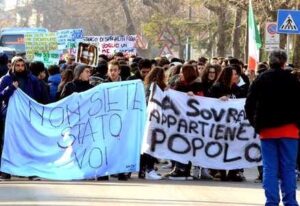
The demonstrations have started out on December 9 called for by autonomous organizations of the toiling masses (peasants, lorry drivers, small entrepreneurs, etc.) but included all sectors of the people hit by the crisis and especially by the sacrifices imposed by the European Union (EU).
Main instrument of struggle are road blocks: In some cases the highway toll stations were occupied completely blocking the traffic. In most cases traffic was slowed down involving private and first of all professional drivers. The mobilization is working: Activists distribute leaflets, drivers stop and sound their horns – now for some two weeks in 135 Italian cities.
In some towns protests were even stronger. In Turin commercial activities were paralyzed for three days. In Genoa and smaller towns trains were blocked while in Perugia the headquarters of the main governmental party PD was occupied. Numerous road blocks took place in the province of Venice where high school students joined in (more in smaller centers than in the big cities).
The really new element is that larger sectors of the people participated in the mobilization by far exceeding the modest clout of the forces constituting the “Committee December 9”. Put differently: Sufficed the signal in order to bring people into motion – often not politicized ones who took to the streets for the first time in their lives.
Beside the impoverished petty bourgeoisie sacrificed on the altar of globalization and strangled by an unsustainable fiscal pressure, young workers – poor, precarious, not unionized, without any traditional class consciousness but indeed conscious that the future will spare for them only misery and exploitation – are playing a protagonist role.
What is the aim of this protest? Different to what one might suggest – and this is also new – there are no partial demands of syndical or categorical type. The objective is straightly political: Not only down with the Letta government but to chase away the entire parliament and the president of the republic, Napolitano. The main slogan is “tutti a casa” (everybody go home) which in the first lecture seems generic and apolitical. It reflects, however, the idea of the necessity of a radical political change to end the dictate of the EU. This “everybody go home” is reinforced by the recent ruling of the constitutional court abrogating the electoral law of 2005 which served as base for the current parliament.
There is a strong demand to regain national and monetary sovereignty (opposition the EU is the common trait of all mobilizations) as well as an affirmative reference to the constitution. People reproach to the government and the presidency to betray the constitution.
The government – which in difference to the Left – understood that the revolt of December 9 is to become a serious challenge. By means of the servile media they preventively have been slandering the movement as being controlled by the extreme Right.
The politically contradictory character of the revolt should not surprise given the social forces involved, given the three decades of decay of the traditional forms of class struggle, given the social decomposition induced by the transformations of production brought about by globalization and casino capitalism. If one adds the snobbish and elitist attitude of the majority of the Left then one can understand the space gained by some Rightist formations.
From the Left we are only few present within this struggle. Beyond the “Popular Liberation Movement” (MPL) there are some other small groups and some “centri sociali” (social centers) from the north. We are ready to go inside, to get “dirty hands”, for this is the only possibility to avoid a shift to the Right by parts of the movement. After some days we register a certain re-consideration also within the ranks of “Rifondazione Comunista” (Communist Refoundation), however, without the immediate hope that they could leave their observer status.
Against this backdrop an open split occurred within the movement. A part of the national co-ordination moved against the demonstration organized on December 18 in Rome. The demonstration definitely was the wrong choice not only because the Right was able to put its mark on it but also because it divided the movement bringing mistrust and disappointment. Eventually it turned out to become a flop.
We support the majority of the national co-ordination not to participate in Rome preferring to continue with local activities. Today the main question is to build provincial committees and to enhance the national leadership rendering it for representative. Only in this way we can enter a second phase developing a coherent political programme thus strengthening the movement to become a real combative political force.